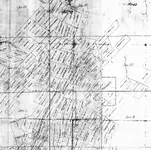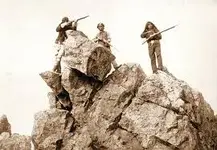Adams Gold Lode Target Possibilities
Was the outcropping situated on a legal mining claim?
As Jacob Snively mentioned in his letter to the
Mesilla Times in 1860, he was aware that
lode mining claims were already being filed by prospectors in the Pinos Altos District as early as 1860. The earliest claims were “quartz claims” in decomposed granite: oxidized zone outcroppings, including quartz veins and stringers that can contain visible gold. The ore was easily mined and the gold was simply recovered with low-tech methods: arrastras to crush the vein material, and placer techniques to recover the free gold. Many such outcroppings were found all over the Pinos Altos vicinity over the years. As many know, these outcroppings erode relatively quickly and are a source for the gold that gradually accumulates into
placer deposits. The exposed outcroppings
can be extremely rich, although often are shallow and short-lived.

Old arrastra, Pinos Altos Mountain
Two of the earliest lode claims filed near Pinos Altos were the
Atlantic (T17S, R13W, Sec 4), and the
Pacific (T17S, R14W, Sec 1) - these were named for which side of the Continental Divide they sat on. A search of the BLM Government Land Office records will yield mineral patent survey plats for these and many other of the larger producing lode claims in the area. Search website:
http://www.glorecords.blm.gov/search/default.aspx?searchTabIndex=0&searchByTypeIndex=1. There were several dozen lode claims that produced enough precious metal to warrant earning a
mineral patent. Most are now more valuable as real estate than for their played-out mineral contents and have been abandoned for many years. Is it possible that one of these mines could have been the source of an ultra-rich surface outcropping that motivated the Adams party and was later discovered and mined by others? It’s impossible to say for sure. There is little or no documentation describing any of the original conditions found for these successful mines. The potential exists, but there is no way to prove anything conclusively.

Former gold mine site, Pinos Altos
Not all mining claims were exploited heavily enough to earn a mineral patent, but there were hundreds filed on and worked around Pinos Altos. Some produced significant quantities of metal in a short period of time, then played out and were abandoned or sold to speculators as the prospectors moved on to new sites and repeated the process with varying degrees of success. Just as with the larger and more successful mines, many of these claims also had
rich surface outcroppings on them. Bear Creek collected its placer gold from all the many eroding outcroppings above it, large and small. Could one of these lesser-known prospects have contained a gold deposit rich enough to be the source of the rumors that inspired the Adams party - possibly an obvious rich outcropping in an easy-to-find location that the Apaches were concerned might be discovered by the miners, causing a larger influx of outsiders? We can’t know the answer, but since gold was present in quantity, the possibility exists. Below is part of a private map drawn in 1950 showing all the then-current mining claims, patented and unpatented, in and around Pinos Altos.

Pinos Altos Mining District, 1950
Along with the development of the Bear Creek placers, the discovery of rich lode claims became a common occurrence between 1860 and 1880 in and around Pinos Altos NM. Do these facts prove that this mineralized zone was the site of the Lost Adams Diggings? No, but the
presence of both placer and lode gold in quantity certainly supports the likelihood that it was a possibility - a key factor missing from so many other proposed LAD sites. Perhaps even more important to confused and frustrated Adams researchers, it also addresses the nagging question: with so many people looking for so many years, why hasn’t the LAD been found? The answer may well be: it
was found, claimed and mined shortly after the Adams events occurred.
Next: rumors of even richer diggings











